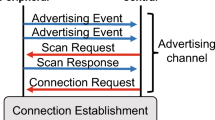Abstract
This paper studied the issue of communication transmission power cost optimization for the personal body base station in wireless body area network (WBAN). With the limited energy capacity, the energy cost for the data exchange between the personal body base station and the medical surveillance network should be controlled. At the same time, the users’ demand should also be guaranteed. The transmission AI choosing distributed optimization model is established, by taking the transmission power consumption as the optimization goal. In this model, the user’s data transmission requirements, wireless environment, location of the AI, and other users ‘choices are comprehensively analyzed. To achieve the optimal users’ AI choosing result for the transmission power cost optimization, the AI choosing game model for transmission power cost of WBAN is constructed, and the game is proved to be an accurate potential game. A transmission power cost optimization AI choosing distributed decision-making algorithm is designed, and the convergence of the algorithm is proved. Experiment analysis verifies the theoretical analysis of the proposed game model and learning algorithm, and show that the proposed algorithm can effectively optimize the AI choosing results of the WBAN to reduce the energy cost.







Similar content being viewed by others
References
Wu, Q., Ding, G., Xu, Y., Feng, S., Du, Z., & Wang, J. (2014). Cognitive internet of things: a new paradigm beyond connection. IEEE Internet of Things Journal,1(2), 129–143.
Ju, C. H., & Shao, Q. (2015). Energy efficiency oriented access point selection for cognitive sensors in internet of things. International Journal of Distributed Sensor Networks,11, 619546.
Nicola, Magnavita. (2018). Medical surveillance, continuous health promotion and a participatory intervention in a small company. International Journal of Environmental Research & Public Health,15(4), 62. https://doi.org/10.3390/ijerph15040662.
Gao, G., Hu, B., Wang, S., & Yang, C. (2018). Wearable circular ring slot antenna with EBG structure for wireless body area network. IEEE Antennas and Wireless Propagation Letters,17(3), 434–437.
Yuce, M. R. (2010). Implementation of wireless body area networks for healthcare systems. Body Users & Actuators A Physical,162(1), 116–129.
Samanta, A., & Misra, S. (2018). Energy-efficient and distributed network management cost minimization in opportunistic wireless body area networks. IEEE Transactions on Mobile Computing,99, 1.
Lee, J., & Kim, S. (2018). Emergency-prioritized asymmetric protocol for improving QoS of energy-constraint wearable device in wireless body area networks. Applied Sciences,8(1), 92.
Zhao, Z., Huang, S., & Cai, J. (2018). An analytical framework for IEEE 802.15.6 based wireless body area networks with instantaneous delay constraints and shadowing interruptions. IEEE Transactions on Vehicular Technology,67(7), 6355–6369.
Shen, J., Gui, Z., Ji, S., Shen, J., & Tan, H. (2018). Cloud-aided lightweight certificateless authentication protocol with anonymity for wireless body area networks. Journal of Network & Computer Applications,106, 117–123.
Samanta, Amit, & Misra, Sudip. (2017). EReM: energy-efficient resource management in body area networks with fault tolerance. IEEE GLOBECOM. https://doi.org/10.1109/GLOCOM.2017.8255012.
Sangwan, A., & Bhattacharya, P. P. (2018). Delay tolerant energy efficient protocol for inter-BAN communication in mobile body area networks. Int J Adv Sci Eng Inf Technol,8(3), 938–948. https://doi.org/10.18517/ijaseit.8.3.4502.
Wu, T. Y., Li, G. H., Huang, S. W., et al. (2012). A GA-based mobile RFID localization scheme for internet of things. Personal and Ubiquitous Computing,16(3), 245–258.
Monderer, D., & Shapley, L. (1996). Potential games. Games and Economic Behavior,14, 124–143.
Marden, J., Arslan, G., & Shamma, J. (2009). Cooperative control and potential games. IEEE Trans Syst Man Cybern B,39(6), 1393–1407.
K. Apt and T. Radzik,”Stable partitions in coalitional games,” arXiv:cs/0605132v1 [cs.GT], May 2006.
Zhong, W., Xu, Y., & Tianfield, H. (2011). Game-theoretic opportunistic spectrum sharing strategy selection for cognitive MIMO multiple access channels. IEEE Transactions on Signal Processing,59(6), 2745–2759.
Young, H. P. (1998). Individual strategy and social structure. Princeton, NJ: Princeton Univ. Press.
Raychaudhuri, D., & Mandayam, N. B. (2012). Frontiers of wireless and mobile communications. Proceedings of the IEEE,100(4), 824–840.
Author information
Authors and Affiliations
Corresponding author
Additional information
Publisher's Note
Springer Nature remains neutral with regard to jurisdictional claims in published maps and institutional affiliations.
Rights and permissions
About this article
Cite this article
Zhang, Y., Jia, Y. & Zhang, X. Demand aware transmission power cost optimization based on game theory and distributed learning algorithm for wireless body area network. Wireless Netw 26, 3203–3215 (2020). https://doi.org/10.1007/s11276-019-02137-w
Published:
Issue Date:
DOI: https://doi.org/10.1007/s11276-019-02137-w




